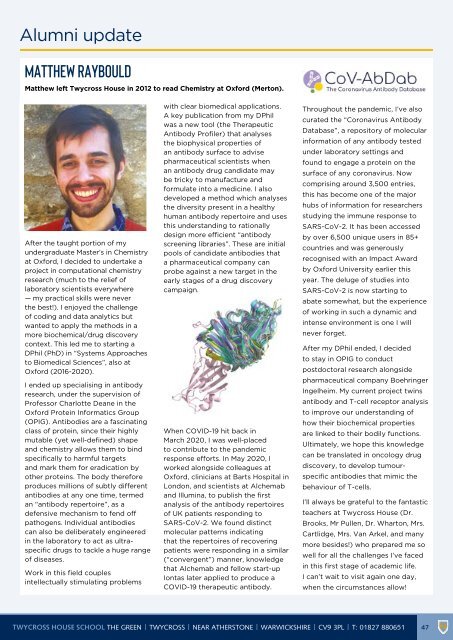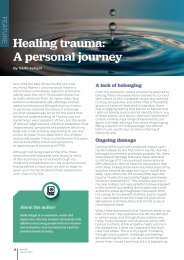Twycross Newsletter AutumnWinter 2021
Create successful ePaper yourself
Turn your PDF publications into a flip-book with our unique Google optimized e-Paper software.
Alumni update<br />
Matthew Raybould<br />
Matthew left <strong>Twycross</strong> House in 2012 to read Chemistry at Oxford (Merton).<br />
After the taught portion of my<br />
undergraduate Master’s in Chemistry<br />
at Oxford, I decided to undertake a<br />
project in computational chemistry<br />
research (much to the relief of<br />
laboratory scientists everywhere<br />
— my practical skills were never<br />
the best!). I enjoyed the challenge<br />
of coding and data analytics but<br />
wanted to apply the methods in a<br />
more biochemical/drug discovery<br />
context. This led me to starting a<br />
DPhil (PhD) in “Systems Approaches<br />
to Biomedical Sciences”, also at<br />
Oxford (2016-2020).<br />
I ended up specialising in antibody<br />
research, under the supervision of<br />
Professor Charlotte Deane in the<br />
Oxford Protein Informatics Group<br />
(OPIG). Antibodies are a fascinating<br />
class of protein, since their highly<br />
mutable (yet well-defined) shape<br />
and chemistry allows them to bind<br />
specifically to harmful targets<br />
and mark them for eradication by<br />
other proteins. The body therefore<br />
produces millions of subtly different<br />
antibodies at any one time, termed<br />
an “antibody repertoire”, as a<br />
defensive mechanism to fend off<br />
pathogens. Individual antibodies<br />
can also be deliberately engineered<br />
in the laboratory to act as ultraspecific<br />
drugs to tackle a huge range<br />
of diseases.<br />
Work in this field couples<br />
intellectually stimulating problems<br />
with clear biomedical applications.<br />
A key publication from my DPhil<br />
was a new tool (the Therapeutic<br />
Antibody Profiler) that analyses<br />
the biophysical properties of<br />
an antibody surface to advise<br />
pharmaceutical scientists when<br />
an antibody drug candidate may<br />
be tricky to manufacture and<br />
formulate into a medicine. I also<br />
developed a method which analyses<br />
the diversity present in a healthy<br />
human antibody repertoire and uses<br />
this understanding to rationally<br />
design more efficient “antibody<br />
screening libraries”. These are initial<br />
pools of candidate antibodies that<br />
a pharmaceutical company can<br />
probe against a new target in the<br />
early stages of a drug discovery<br />
campaign.<br />
When COVID-19 hit back in<br />
March 2020, I was well-placed<br />
to contribute to the pandemic<br />
response efforts. In May 2020, I<br />
worked alongside colleagues at<br />
Oxford, clinicians at Barts Hospital in<br />
London, and scientists at Alchemab<br />
and Illumina, to publish the first<br />
analysis of the antibody repertoires<br />
of UK patients responding to<br />
SARS-CoV-2. We found distinct<br />
molecular patterns indicating<br />
that the repertoires of recovering<br />
patients were responding in a similar<br />
(“convergent”) manner, knowledge<br />
that Alchemab and fellow start-up<br />
Iontas later applied to produce a<br />
COVID-19 therapeutic antibody.<br />
Throughout the pandemic, I’ve also<br />
curated the “Coronavirus Antibody<br />
Database”, a repository of molecular<br />
information of any antibody tested<br />
under laboratory settings and<br />
found to engage a protein on the<br />
surface of any coronavirus. Now<br />
comprising around 3,500 entries,<br />
this has become one of the major<br />
hubs of information for researchers<br />
studying the immune response to<br />
SARS-CoV-2. It has been accessed<br />
by over 6,500 unique users in 85+<br />
countries and was generously<br />
recognised with an Impact Award<br />
by Oxford University earlier this<br />
year. The deluge of studies into<br />
SARS-CoV-2 is now starting to<br />
abate somewhat, but the experience<br />
of working in such a dynamic and<br />
intense environment is one I will<br />
never forget.<br />
After my DPhil ended, I decided<br />
to stay in OPIG to conduct<br />
postdoctoral research alongside<br />
pharmaceutical company Boehringer<br />
Ingelheim. My current project twins<br />
antibody and T-cell receptor analysis<br />
to improve our understanding of<br />
how their biochemical properties<br />
are linked to their bodily functions.<br />
Ultimately, we hope this knowledge<br />
can be translated in oncology drug<br />
discovery, to develop tumourspecific<br />
antibodies that mimic the<br />
behaviour of T-cells.<br />
I’ll always be grateful to the fantastic<br />
teachers at <strong>Twycross</strong> House (Dr.<br />
Brooks, Mr Pullen, Dr. Wharton, Mrs.<br />
Cartlidge, Mrs. Van Arkel, and many<br />
more besides!) who prepared me so<br />
well for all the challenges I’ve faced<br />
in this first stage of academic life.<br />
I can’t wait to visit again one day,<br />
when the circumstances allow!<br />
47



